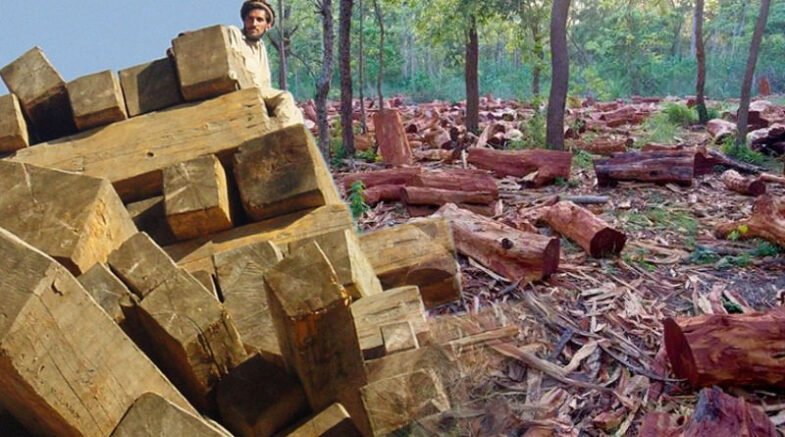Deforestation in riparian and coastal areas exacerbated floods and facilitated seawater intrusion, resulting in massive economic losses to the government coffers.

According to the National Forest Policy 2015, deforestation in Pakistan watershed areas has reduced agricultural yield and the quantity of water available at outlets, as well as causing land degradation and the loss of biodiversity and wildlife in Khyber Pakhtunkhwa.
Deforestation in riparian and coastal areas, particularly in Sindh and Balochistan, exacerbated floods and facilitated seawater intrusion, resulting in massive economic losses to the government coffers, as evidenced by the devastating 2010 and 2022 floods.
According to the National Forest Policy 2015, forest resources in all provinces, particularly in KP and Gilgit Baltistan, were under severe strain, particularly in communal lands, shamalats, guzaras, and privately owned forests.
According to policy, Pakistan’s total forest-covered area was 5%, and the country was losing approximately 27,000 hectares of forest per year, the majority of which occurred in private and community-owned natural forests.
When comparing Pakistan’s deforestation rate to that of the rest of the world, Dr. Mumtaz Malik, former Chief Conservator of Wildlife KP, stated that globally, around 10 million hectares of forest are deforested every year, equivalent to the area of Portugal, and that roughly half of this deforestation is offset by forest regrowth, implying that globally, around five million hectares of “green gold” are lost each year.
“Overpopulation, poverty, and unnecessary tree logging were among the major causes of deforestation in KP Pakistan,” said Dr. Mumtaz Malik, adding that in 1947, Pakistan’s population was only 37 million, which jumped to a record 223 million in 2022 and is expected to reach 260.3 million in 2030 and 330.8 million by 2050, resulting in the extinction of green gold, wildlife, and bees.
According to Dr. Mumtaz, approximately 68 percent of the country’s forests are used for firewood, and 15 percent of trees are being lost due to urbanisation and community-driven demands.
“If we do not change our green sector policies and shift to the adaptation of alternative energy resources such as solar, hydroelectric, and wind, then there is every possibility of losing the existing forests in the next two decades, besides witnessing frequent climate change disasters,” he added.
Dr. Mumtaz stated that deforestation was a national challenge and that a “green emergency” was needed to conserve and protect the green gold by looking beyond party politics. He also proposed a deal between Pakistan and Afghanistan to control timber smuggling.
A former Environment and Forests Minister said that thousands of trees planted under the billion-dollar tree afforestation project were cut down prematurely in Khyber Pakhtunkhwa, in violation of an agreement signed between the KP forest department and farmers.
According to Gulzar Rehman, Conservator Forests, the KP Forest Ordinance 2002 established a Forest Force with police-like powers to protect forest resources and conduct operations against the timber mafia.
“The KP forest force was outfitted with the necessary weaponry, ammunition, vehicles, and a communication system, as well as the authority to shoot offenders and timber mafia in self-defense if laws were broken.”
Forest officers have the authority to arrest, detain, or take an accused person into custody, as well as inspect any vehicle, boat, railway waggon, or pack animal, and seize smuggled timber.
According to Gulzar Rehman, DFOs and RFOs can enter any depot, wood or saw cutting unit, building, or any other premises to search and seize timber and arrest offenders, in addition to conducting investigations, making inquiries, and arresting any offender without a warrant from a magistrate.
Gulzar Rehman stated that the forest force’s jurisdiction has been extended to merged areas, and checkpoints have also been established on national and regional highways and roads to prevent timber trafficking.
He proposed special forest courts for speedy prosecution of the accused, increased lockups, modern wireless systems, and mobility vehicles to combat timber smuggling.
According to Muhammad Ibrahim Khan, Deputy Project Director of the 10 billion tree afforestation project, deforestation is a major cause of climate change, and the project planted approximately 650.17 million saplings in KP until September 30, 2022, to offset its impact.
He emphasised the importance of launching the COP 29 UN fund to assist countries affected by climate change and deforestation, including Pakistan.
70-year-old Amanullah Khan was busy like a honeybee in cutting timber of native and indigenous species with a big saw in his ‘wood taal’ with the support of five laborers located at Pabbi station on main GT Road in Nowshera. His sons were seen helping his father in preparing bundles of endangered Shisham, Phulai, Ber, Kikar, Poplar, Neem, Amaltas, Saru and Jaman in his business place.
Demand for firewood in Pakistan is highest in December-January due to shortage of natural gas and high prices of LPG cylinder, says Amanullah, a firewood dealer from Peshawar. The price of one mound (50kg) of firewood starts from Rs 600 to Rs 700 depending on the quality of the timber, he says.
Drivers on the main road between Tarnab Peshawar and Azakhel Nowshera can see a large number of cut timbers and uprooted trunks of trees at wood taals. This is due to the high rate of deforestation in Pakistan, especially in Khyber Pakhtunkhwa.
